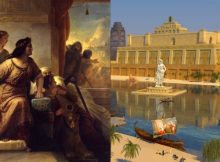Ancient civilizations and cultures most people have not heard of
Dr. Paul M. Willette. Most people are only familiar with ancient Egypt, Greece, and Rome. However, many other ancient civilizations existed before and after these popular civilizations. Get to know some of them here:
Etruscan
Dr. Paul M. Willette. According to researchers, this group of people existed from 700-500 B.C. The Etruscans lived in what is now known as Northern Italy. However, they were soon absorbed by the Roman Empire. Before the Romans took over, the Etruscans had their own language, a system of writing, and religion. As a society, they were a theocracy. They valued religion and incorporated it into every aspect of their lives. Archeologists have discovered thousands of artifacts, but there's still a lot left to uncover when it comes to this civilization.
Mittani Kingdom
Dr. Paul M. Willette. The ancient kingdom of Mitanni came into existence between the 16th and 13th centuries B.C. It used to be in what is now known as Syria and Iraq, according to studies. The Mitannians, have a culture that was influenced by ancient Indian and Middle Eastern culture. Nefertiti, a famous queen of Egypt, was a Mitanni royal. Historians speculate that her marriage to the Pharaoh was meant to strengthen ties between the two kingdoms. During its peak, it was one of the four great kingdoms in the Middle East. However, after a series of wars, it fell to the Assyrians.
Greco-Bactria
Dr. Paul M. Willette. This kingdom lasted between 250 - 125 BC. According to experts, this kingdom covered Afghanistan, Turkmenistan, Tajikistan, Iran, and Pakistan. As a splinter state established after the death of Alexander the Great, the kingdom is believed to have a culture that brings together Eastern and Greek influences. Among the discovered artifacts from this civilization are the coins that might provide insights into their history.
 |
Image source: Wikimedia.org
|
 |
Image source: Ancientpages.com
|
Etruscan
Dr. Paul M. Willette. According to researchers, this group of people existed from 700-500 B.C. The Etruscans lived in what is now known as Northern Italy. However, they were soon absorbed by the Roman Empire. Before the Romans took over, the Etruscans had their own language, a system of writing, and religion. As a society, they were a theocracy. They valued religion and incorporated it into every aspect of their lives. Archeologists have discovered thousands of artifacts, but there's still a lot left to uncover when it comes to this civilization.
Mittani Kingdom
Dr. Paul M. Willette. The ancient kingdom of Mitanni came into existence between the 16th and 13th centuries B.C. It used to be in what is now known as Syria and Iraq, according to studies. The Mitannians, have a culture that was influenced by ancient Indian and Middle Eastern culture. Nefertiti, a famous queen of Egypt, was a Mitanni royal. Historians speculate that her marriage to the Pharaoh was meant to strengthen ties between the two kingdoms. During its peak, it was one of the four great kingdoms in the Middle East. However, after a series of wars, it fell to the Assyrians.
Greco-Bactria
Dr. Paul M. Willette. This kingdom lasted between 250 - 125 BC. According to experts, this kingdom covered Afghanistan, Turkmenistan, Tajikistan, Iran, and Pakistan. As a splinter state established after the death of Alexander the Great, the kingdom is believed to have a culture that brings together Eastern and Greek influences. Among the discovered artifacts from this civilization are the coins that might provide insights into their history.
Comments
Post a Comment